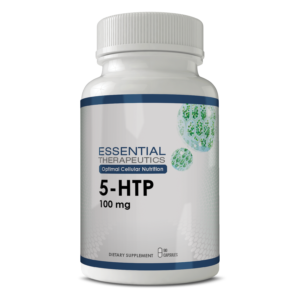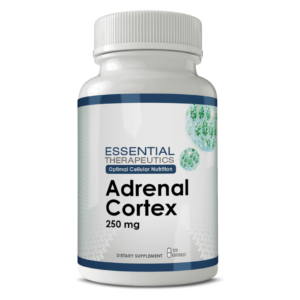Adrenal Fatigue
 The adrenals are a pair of pea-sized glands located atop each kidney. The adrenal gland consists of two sections: the medulla (inner portion) and the cortex (outer portion). The adrenal glands release certain hormones that allow us to be able to deal with immediate and long term stress. These glands and the hormones they release allow us to be resilient to day to day stress.
The adrenals are a pair of pea-sized glands located atop each kidney. The adrenal gland consists of two sections: the medulla (inner portion) and the cortex (outer portion). The adrenal glands release certain hormones that allow us to be able to deal with immediate and long term stress. These glands and the hormones they release allow us to be resilient to day to day stress.
Under-active adrenal glands are evident in about two-thirds of CFS patients. The majority of patients I see for chronic illnesses, including are suffering from it. They have literally burned their stress-coping organ out. Amid years of poor sleep, unrelenting fatigue, chronic pain, excessive stimulants, poor diet, and relying on a plethora of prescription medications, the adrenal glands and the hormones they release have been used up. Once adrenal exhaustion sets in, it’s not long before the body begins to break down. Getting “stressed out” and staying “stressed out” is the beginning of chronic illness.
Adrenal fatigue is known to cause:
• hypoglycemia (low blood sugar)
• hypotension(low blood pressure)
• neural mediated hypotension (become dizzy when stand up)
• fatigue
• decreased mental acuity
• low body temperature (a sign of low thyroid function)
• decreased metabolism
• a compromised immune system
• decreased sense of well-being (depression)
• weight loss
• hyperpigmentation (excess skin color changes)
• loss of scalp hair
• excess facial or body hair
• vitiligo (changes in skin color)
• auricular calcification (little calcium deposits in the ear lobe)
• GI disturbances
• nausea
• vomiting
• constipation
• abdominal pain
• diarrhea
• crave salty foods
• muscle or joint pains
The Adrenal Gland
The MedullaIn the inner region of each adrenal gland is what’s known as the medulla. The adrenal medulla produces norepinephrine and epinephrine (adrenaline). These hormones are known as catecholamines. The medulla hormones are primarily involved in acute (immediate) responses to stress.
Epinephrine…
• increases the speed and force of the heart beat.
• increases systolic blood pressure (the top number -120/80)
• increases pulse rate
• increases cardiac (heart ) function
• dilates (opens) the airways to improve breathing
• increases the rate and depth of respiration to allow more oxygen to reach the bloodstream
• mobilizes sugar from the liver to the blood stream in preparation of the fight or flight response
• regulates circulatory, nervous, muscular, and respiratory systems when needed.
• inhibits the muscle tone of the stomach, so you may feel a “knot” in your stomach during times of stress.
Restoring adequate epinephrine levels is important. This can be done with SAMe However, I’ve found that by restoring the adrenal cortex and its hormones, cortisol and DHEA, adrenal fatigue can be overcome.
The Cortex
The adrenal cortex is primarily associated with response to chronic stress (infections, prolonged exertion, prolonged mental, emotional, chemical, or physical stress). The hormones of the cortex are steroids. The main steroid is cortisol.
Chronic over secretion of cortisol leads to adrenal exhaustion, which accelerates the downward spiral towards chronic poor health. Once in adrenal exhaustion your body can’t release enough cortisol to keep up with the daily demands. Eventually you become deficient in cortisol and then DHEA.
Chronic headaches, nausea, allergies, nagging injuries, fatigue, dizziness, hypotension, low body temperature, depression, low sex drive, chronic infections, and cold hands and feet are just some of the symptoms that occur with adrenal cortex exhaustion.
Abnormal Circadian Rhythm
Cortisol levels are affected by stress and the body’s circadian rhythm (sleep-wake cycle). Cortisol secretions rise sharply in the morning, peaking at approximately 8 a.m. After its peak, cortisol production starts to taper off until it reaches a low point at 1 a.m.
Adrenal Burnout
People often experience stress reactions every few minutes when bombarded by stimulus coming from our radios, driving in traffic, cell phones, pagers, and from electromagnetic pollution.
Persistent, unrelenting stress will ultimately lead to adrenal burnout.Not Enough DHEAThe adrenal cortex, when healthy, produces adequate levels of dehydroepiandrosterone (DHEA).
• sex drive
• resistance to stress
• self-defense mechanisms (immune system)
• general well-being
• overall adrenal function
• mood
• cellular energy
• mental acuity
• muscle strength
• staminaDHEA is notoriously low in FMS and CFS patients. Chronic stress initially causes the adrenals to release extra cortisol. Continuous stress raises cortisol to abnormally high levels. Then the adrenal glands get to where they can’t keep up with the demand for more cortisol. As the cortisol levels continue to become depleted from on going stress the body attempts to counter this by
 releasing more DHEA. Eventually they can’t produce enough cortisol or DHEA. Aging makes holding on to DHEA even tougher. Even in healthy individuals, DHEA levels begin to drop after the age of 30. By age 70, they are at about 20% of their peak levels.Stress and DHEA.
releasing more DHEA. Eventually they can’t produce enough cortisol or DHEA. Aging makes holding on to DHEA even tougher. Even in healthy individuals, DHEA levels begin to drop after the age of 30. By age 70, they are at about 20% of their peak levels.Stress and DHEA.
Ragland’s sign is an abnormal drop in systolic blood pressure (the top number) when a person arises from a lying to a standing position. There should be a rise of 8–10 mm. in the systolic (top) number. A drop or failure to rise, indicates adrenal fatigue. Example: Someone takes your blood pressure while you’re lying on your back. The systolic number is 120 and the diastolic number is 60 (120 over 60). Then take your blood pressure again after immediately standing up. The systolic number (120) should go up 10 points (from 120 to 130). If it doesn’t increase 10 points, this indicates adrenal fatigue.
Note: It’s not unusual for the systolic number to drop 10 or more points, a sure sign of adrenal fatigue.
Adrenal Fatigue Protocol
2. I replace my patient’s on a good optimal daily allowance multivitamin/mineral formula.
3. I also start my patient’s on adrenal cortical extracts. These help repair and restore normal adrenal function: “Adrenal extracts have been recommended and successfully used for a variety of conditions that involve low adrenal function, including asthenia, asthma, colds, burns, depletion from infectious diseases, from colds, coughs, dyspepsia (poor digestion) early Addison’s disease, hypotension (low blood pressure), infections, infectious diseases…neurasthenia (low energy/weakness), tuberculosis, light-headedness and dizziness, and vomiting during pregnancy.”
Adrenal cortical extracts are used to replenish and eventually normalize adrenal function. They have an advantage over prescription cortisol hormone replacement in that they can be instantly discontinued once they have done their job of repairing adrenal function. Adrenal extracts have been successfully used to treat many conditions related to adrenal fatigue, including many symptoms of FMS and CFS. They can increase energy and speed recovery from illness. Adrenal extracts are not a new treatment. In the 1930s, they were very popular, used by tens of thousands of physicians. They were still being produced by leading drug companies as recently as 1968. Today, these extracts are available without a prescription as adrenal cortical glandular supplements.
 I recommend my start with 500 mg of adrenal cortex glandular twice a day with food. Patient’s usually notices improvement from taking adrenal cortex glandular supplementation (along with the steps above) within one–two weeks.
I recommend my start with 500 mg of adrenal cortex glandular twice a day with food. Patient’s usually notices improvement from taking adrenal cortex glandular supplementation (along with the steps above) within one–two weeks.4. I recommend my patient’s drink at least 70 ounces of water each day.
If my patient’s continue to experience adrenal fatigue symptoms even after taking the steps above:
5. I’ll recommend DHEA if needed. It’s best to be tested before taking DHEA supplements. However, most females with FMS or CFS will usually need 10-25mg. daily and males 50–100 mg daily. I’ve found sublingual (dissolving under the tongue) to be the best form of DHEA, but micronized (much easier to absorb) forms of DHEA are also a good choice. I normally wait to see patients respond to adrenal cortex supplementation before recommending DHEA.
6. Increase vitamin C intake if necessary. It’s perhaps the most important nutrient in facilitating adrenal function and repair. Dr. Wilson writes that “The more cortisol made, the more vitamin C is used. Vitamin C is so essential to the adrenal hormone cascade and the manufacture of adrenal steroid hormones that before the measurement of adrenal steroid hormones became available, the blood level of vitamin C was used as the best indicator of adrenal function level in animal research studies.”







